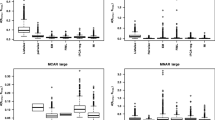Abstract
Many model selection criteria proposed over the years have become common procedures in applied research. However, these procedures were designed for complete data. Complete data is rare in applied statistics, in particular in medical, public health and health policy settings. Incomplete data, another common problem in applied statistics, introduces its own set of complications in light of which the task of model selection can get quite complicated. Recently, few have suggested model selection procedures for incomplete data with varying degrees of success. In this paper we explore model selection by the Akaike Information Criterion (AIC) in the multivariate regression setting with ignorable missing data accounted for via multiple imputation.
Similar content being viewed by others
References
Akaike, H.: A new look at statistical model identification. IEEE Trans. Autom. Control 19(6), 716–723 (1974)
Burnham, K., Anderson, D.: Multimodel inference: understanding AIC and BIC in model selection. Sociol. Methods Res. 33, 261–304 (2004)
Chamberlain, T.: The method of multiple working hypotheses. Science 15, 93 (1890)
Claeskens, G., Consentino, F.: Variable selection with incomplete covariate data. Biometrics 64, 1062–1096 (2008)
Collins, L., Schafer, J., Kam, C.: A comparison of inclusive and restrictive strategies in modern missing data procedures. Psychol. Methods 6, 330–351 (2001)
Consentino, F., Claeskens, G.: Order selection tests with multiply-imputed data. Comput. Stat. Data Anal. 54(10), 2284–2295 (2010)
Harel, O.: Inferences on missing information under multiple imputation and two-stage multiple imputation. Stat. Method. 4, 75 (2007)
Harel, O.: The estimation of R 2 and adjusted R 2 in incomplete data sets using multiple imputation. J. Appl. Stat. 36(10), 1109–1118 (2009)
Hurvich, C., Tsai, C.: Regression and time series model selection in small samples. Biometrika 76, 297–307 (1989)
Hurvich, C., Tsai, C.: The impact of model selection on inference in linear regression. Am. Stat. 44, 214–217 (1990)
Ibrahim, J.G.: Incomplete data in generalized linear models. J. Am. Stat. Assoc. 85, 765–769 (1990)
Little, R., Rubin, D.: Statistical Analysis with Missing Data, 2nd edn. Wiley, New York (2002)
Meng, X.-L., Rubin, D.B.: Performing likelihood ratio tests with multiply-imputed data sets. Biometrika 79, 103–11 (1992)
Miller, A.: Subset Selection in Regression. Chapman & Hall, London (2002)
Rao, C., Wu, Y.: Model selection. Lecture Notes-Monograph Series 38, 1–64 (2001)
Rubin, D.: Inference and missing data. Biometrika 63, 581 (1976)
Rubin, D.: Multiple Imputation for Nonresponse in Surveys. Wiley, New York (1987)
Schafer, J.: Analysis of Incomplete Multivariate Data. Chapman and Hall, London (1997)
Schafer, J., Graham, J.: Missing data: our view of the state of the art. Psychol. Methods 7, 147 (2002)
Wood, A.M., White, I.R., Royston, P.: How should variable selection be performed with multiply imputed data? Stat. Med. 27, 3227–3246 (2008)
Yang, X., Belin, T.R., Boscardin, W.J.: Imputation and variable selection in linear regression models with missing covariates. Biometrics 61(2), 498–506 (2005)
Acknowledgments
We would like to thank the referees for providing comments that helped in improving the quality of our paper. This project was partially supported by Award Number K01MH087219 from the National Institute of Mental Health. The content is solely the responsibility of the authors and does not necessarily represent the official views of the National Institute of Mental Health or the National Institutes of Health.
Author information
Authors and Affiliations
Corresponding author
Appendix
Appendix
In order to interpret the simulation results that follow, we use certain labels to indicate variables (model) selected by each AIC type as “best”. These labels are as follows: \({{\mathcal{C}}}\) indicates the variables in the true data generating model i.e. \({\{\user2{x}_1 \, \user2{x}_2\}, {\mathcal{I}}}\) indicates the variables in the true imputation model i.e. {x 1 x 2 x 3} when p = 3 and {x 1 x 2 x 3 x 4} when \({p=4, \, {\mathcal{I}}_{\user2{x}_1}}\) indicates the model with x 1 and variables other than \({\user2{x}_2,\,{\mathcal{I}}_{\user2{x}_2}}\) indicates the model with x 2 and variables other than \({\user2{x}_1, \, {\mathcal{O}}}\) indicates over-fitted models that contain true data generating variables and some other variables (for \({p=3, \, {\mathcal{I}}={\mathcal{O}}}\)), \({{\mathcal{W}}}\) indicates models not containing any of the true data generating variables (Tables 3, 4, 5, 6, 7, 8, 9, 10).
Rights and permissions
About this article
Cite this article
Chaurasia, A., Harel, O. Using AIC in multiple linear regression framework with multiply imputed data. Health Serv Outcomes Res Method 12, 219–233 (2012). https://doi.org/10.1007/s10742-012-0088-8
Received:
Revised:
Accepted:
Published:
Issue Date:
DOI: https://doi.org/10.1007/s10742-012-0088-8




